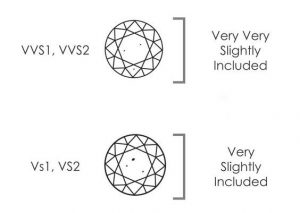Clarity is known for being one of the four Cs of diamond rating which lets you know whether you have a good diamond or a mediocre one. But how can you actually tell if the diamond has the clarity that you have been promised? Let us take a look at the clarity and what it means.
What is Clarity?
A diamond’s clarity refers to how well it allows light to flow through and out of the table of the stone. It has nothing to do with the color of the stone, which can be confusing as the ‘best’ color for a diamond is completely see-through – or clear! Rather, natural diamonds tend to show the signs of their great age and strenuous creation process – in the depths of a volcano, billions of years ago – with imperfections known as inclusions or occlusions. Inclusions appear inside the stone, while occlusions appear on the outside, and both of these can include contaminants, cracks, feather fractures, and warping within the material of the diamond. The more of these in the stone, the lower its clarity grading will be, with FL/IF (Flawless/ Internally Flawless) being the top grading.
How is Clarity Checked?
Diamonds are best graded upon cutting before they are mounted or set in any way. They should be examined in a bright even light, against a pure white background, and always at a minimum of 10x magnification. Each diamond’s cut is designed to minimize the appearance of any flaws, so the examination must be slow and painstaking, with the stone carefully examined from every possible angle to spot potential issues within the stone. If stones have inclusions or flaws that can only be seen under a magnification of ten or more but seem perfect to the naked eye, then they are deemed to be eye clean, which can be a positive selling point, especially for more budget-conscious diamond buyers.
Best Ways to be Sure!
The best way to be sure of the clarity of your diamond is to get it certified – or better yet, only buy a diamond that already has a certificate from a reputable diamond grading company. The two main authorities in the USA for diamond grading are AGS and GIA, both of whom certify any diamonds that pass through their hands. They have stringent certification processes and thus are accepted as being globally trustworthy – some other companies tend to err on the generous side, marking up diamonds that are not worthy of the rating given, or including enhanced or lab-grown diamonds in their remit. GIA and AGS refuse to rate enhanced or lab-grown stones.
If you are offered a diamond that has already been mounted in a piece of jewelry, you are highly unlikely to be able to tell its clarity with your own vision, even enhanced by 10x magnification. If you examine this diamond clarity chart, you will soon see that the differences between one rating level and another are so very slight that even in lab conditions with bright lights and no setting to deal with, it can be hard to pinpoint exactly where a diamond falls on the clarity levels.
















Leave a Reply